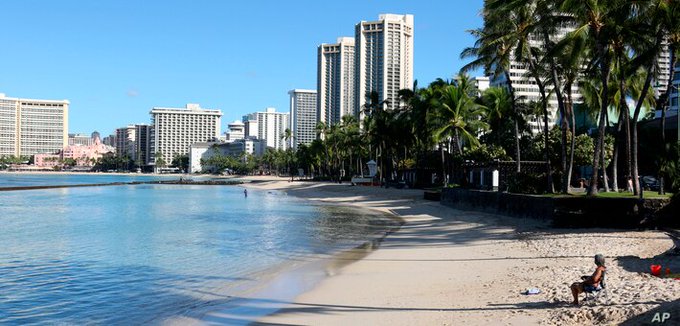Hawaii faces a range of environmental problems caused by global warming, impacts worsened by practices that critics say have ignored the local ecology.
They say reviving traditional values can reduce the damage by limiting coastal erosion, reversing the rising acidity of coastal waters and lessening flooding from intense storms.
Coastal hotels and homes already are seeing the effect of rising sea levels, which could cost the state’s principal island of Oahu 40 percent of its beaches by 2050, according to one study. That also would harm tourism, which is the largest source of income for the islands.
Even under an optimistic global scenario assuming lower greenhouse gas emissions, sea levels will rise 30 centimetres by the end of the century, according to current estimates. Under a worst-case scenario, ocean levels could rise more than 2 metres by 2100, devastating coastal regions and displacing whole communities on these islands.
The 2015 Paris Agreement aims to limit global warming to 1.5 degrees Celsius compared to preindustrial levels.
Both air and ocean temperatures are rising, and acidity is increasing as oceans absorb more carbon dioxide, damaging coral reefs and sea life.
Changes in weather patterns cause erratic precipitation, and in some places, drought.
“Some rainfall is on average going up over time. Some is going down,” said Victoria Keener, who studies climate change and natural resource management at Honolulu’s East-West Centre. “In Hawaii, we’ve actually seen drying out,” with increased fire risk in parts of the islands and more rapid warming and environmental changes at higher elevations, she said.
Unstable weather triggered severe storms and flooding on Maui and other islands in March, destroying homes and bridges and providing a preview, scientists said, of what can happen in the future.
Moreover, climate change has additional consequences, Keener said, contaminating “groundwater wells near the coast,” harming agriculture and threatening infrastructure.
Honolulu is a modern urban centre, and the island of Oahu, where the city is located, is home to some 950,000 people. As the population has grown, authorities have paved over natural waterways to control flooding, blocking the natural watersheds that once linked the mountains, lowlands and coast in a single ecosystem.
Celeste Connors of Hawaii Green Growth, a non-profit organisation that works to implement the United Nations sustainable development goals, stands on the edge of the watershed above the Manoa Valley, which drains rainfall from the mountains toward the coast. Nearby is a restored heiau, an ancient religious and ceremonial site located on the grounds of the Manoa Heritage Centre.
Connor said this was the centre of a natural system that linked these hills to the farming lowlands and coastal Waikiki.
It is called an ahupua’a, which refers both to the land unit and the system of managing resources from “ridge to reef,” said Connors, all driven by an ethic of stewardship that Hawaiians call mālama.
There are efforts around the islands to renew traditional farming methods and values. On the east or windward shore of Oahu, farmer Nick Reppun works for a non-profit group that grows traditional staple foods such as breadfruit and taro, restoring these lowland wetlands to their natural state.
The farm borders a housing development in an area once slated for luxury homes, a marina and golf course before a public agency intervened in 1991. Today, conservation and heritage groups are restoring the mountain watershed and coastal aquaculture pond, reviving another ancient, interconnected ahupua’a.
“We’re just trying to do what we know has been done and what we know worked before,” said Reppun, farm director at the project called Kāko’o ‘Ōiwi. “We’re not reinventing the wheel with these systems, just trying to revive them,” he said.
Today, these islands are far from self-sufficient, importing 85% to 90% of their food from outside — something long seen as a vulnerability. Researcher Hunter Heaivilin of the University of Hawaii noted that there were efforts in World War I to secure the food supply and boost the local production of taro.
In 1949, the islands suffered a 177-day shipping strike, and a 100-day West Coast dock strike slashed imports in 1971, causing shortages and again highlighting the problem.
Heaivilin said today, bottom-up efforts to increase self-sufficiency include food hubs that connect small farms and buyers.
There are no easy solutions to the problems of climate change, but experts say islands are ground zero for studying climate change and are a repository of knowledge about community resilience.
The local Aloha+ Challenge tracks progress toward the UN sustainable development goals, measuring successes and shortcomings in areas from clean energy to food production. Connors of Hawaii Green Growth said the challenge, which takes its name from the traditional Hawaiian greeting, suggests a way of life rooted in these islands.
Alapaki Luke, a teacher of Hawaiian language and culture at Honolulu Community College, points to a wetland taro patch that traps the silt that would otherwise flow downstream to the ocean. Located on the grounds of the School of Hawaiian Knowledge at the University of Hawaii, he said it showcases traditional wisdom about land and water use and ways to prevent erosion.
“I’m not about going back 400 or 500 years,” he said. “But we can use the foundation, which we call the kahua, of the ‘ike, the native tradition, in a modern setting,” using ancient knowledge that he said is state of the art.
SOURCE: VOA/PACNEWS














